Before I tell you more about my quest for the forgotten grandfather in my life, we have two places to visit. The first takes us back to the era of parchment, the quill, and the book. The other takes us to the wrenching revolution of steam, smoke and iron machines.
Our route took us right past Collegeville, Minnesota, home of St. John’s University and its famed Abbey Church. I had spent a now-distant summer here with T. J. Bachmeyer at the Institute for Ecumenical and Cultural Research, where we worked out the outlines of our book on theology and the behavioral sciences. Sylvia had never been there, so we hopped off the Interstate and plunged into the quiet early fall of the lovely campus. We arrived before the massive bell façade of the church just as the bells were tolling noon. The monks had gathered for their prayers and we hushed ourselves into the rear pews to take in the sonorous readings and reverberating prayers. The stained glass windows sparkled a transcendent sun into the concrete interior. We paid a visit to the lovely fourteenth century wooden Madonna and child in a side chapel before finding our way to the library and its display of pages from the newly-completed St. John’s Bible.
and plunged into the quiet early fall of the lovely campus. We arrived before the massive bell façade of the church just as the bells were tolling noon. The monks had gathered for their prayers and we hushed ourselves into the rear pews to take in the sonorous readings and reverberating prayers. The stained glass windows sparkled a transcendent sun into the concrete interior. We paid a visit to the lovely fourteenth century wooden Madonna and child in a side chapel before finding our way to the library and its display of pages from the newly-completed St. John’s Bible.
This is truly a remarkable artistic and devotional accomplishment. The Benedictine community of St. John’s decided some years back to authorize a contemporary Bible, in the New Revised Standard Version, that would be composed with the ancient art of quill pen calligraphy on parchment and illuminated with strikingly modern art. 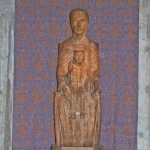 Donald Jackson, calligrapher to Queen Elizabeth II, worked with his crew for some eleven years to bring forth an exquisite set of Bibles that are now touring the world. Funds were raised from many interested sponsors to pay for the multi-million dollar work. You can find out more at their website. If it comes near you, don’t miss this chance to see this work of patient craft, vivid imagination, and historical commitment.
Donald Jackson, calligrapher to Queen Elizabeth II, worked with his crew for some eleven years to bring forth an exquisite set of Bibles that are now touring the world. Funds were raised from many interested sponsors to pay for the multi-million dollar work. You can find out more at their website. If it comes near you, don’t miss this chance to see this work of patient craft, vivid imagination, and historical commitment.
The next day my daughter Elaine and her husband Steve took us to the Western Minnesota Steam Thresher Reunion. Haven’t heard of it? Neither had we. But about ten thousand other people had. In the middle of rolling farmland, just outside the hamlet of Rollag, we headed for a cloud of smoke hovering over a vast parking lot of the assembled pilgrims. Every Labor Day weekend they assemble to operate every manner and description of steam engines that revolutionized agriculture in the last 150 years. A steam locomotive pulls open freight cars filled with visitors around the periphery, while people lovingly tend tractors, threshing machines, sawmills, corn-shuckers, steam generators, steamrollers and reapers. Many visitors,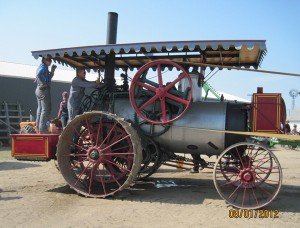 including my six-year old granddaughter Hazel, wore period dress. Others, like some Mennonites, still do. Lunch was served by the local Lutheran churches. It was a vintage Garrison Keillor event.
including my six-year old granddaughter Hazel, wore period dress. Others, like some Mennonites, still do. Lunch was served by the local Lutheran churches. It was a vintage Garrison Keillor event.
As I stood watching the old threshing machine discharging its wheat and seeds, I said to one of the men tending the machine, “Except for the seed chute, this is exactly the machine I worked with as a boy.” “Yep,” he answered. “They stopped making ’em in 1950.” It was just yesterday.
Alongside the billows of smoke and clanking noises, across the tracks lay a pre-industrial barnyard, where draft horses were pulling McCormick reapers and harrows around a field of wheat. The stark contrast helped us relive within a hundred yards the wrenching change from an animal-powered agriculture to an industrial one. 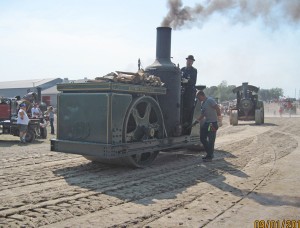 While the clouds of smoke from that era have finally begun to dissipate in our land (but not in China and India!), we still have questions to ask about what the change has meant for health, welfare, the land, and human organization. Both ways of life have their allure and profound attraction. Come to Rollag next Labor Day and experience it for yourself. You can even enroll in the Rollag University of Steam Engineering. You won’t forget it.
While the clouds of smoke from that era have finally begun to dissipate in our land (but not in China and India!), we still have questions to ask about what the change has meant for health, welfare, the land, and human organization. Both ways of life have their allure and profound attraction. Come to Rollag next Labor Day and experience it for yourself. You can even enroll in the Rollag University of Steam Engineering. You won’t forget it.
The experience of St. John’s, with its quiet reclamation of an ancient art rooted in relgious contemplation, placed back-to-back with the cacophony of industrial machinery, belching smoke and oozing oil, intensified my awareness of the vivid contrasts that color our lives. Both are re-enactments of ways of life, of aspirations for transformation of received existence, of our ever-puny efforts to control our destiny and dominate our earth.
With that awareness, we will come to our next stop in Hibbing, Minnesota, the center of the Mesabi, the largest deposit of iron ore in the world and the catalyst of America’s industrial development. (I know, it’s also the home of Bob Dylan, or at least the shape-shifter that took that name.) See you next week.

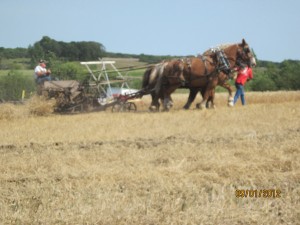
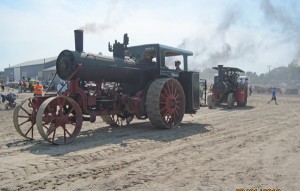
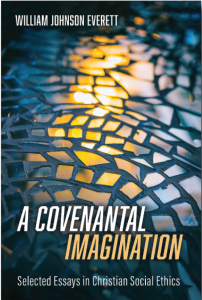
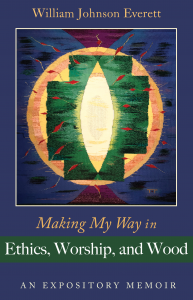


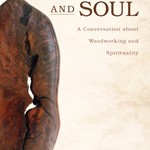
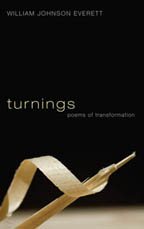
 Red Clay, Blood River
Red Clay, Blood River